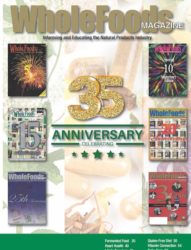If you missed the event, every session is available on-demand, for free, atNaturallyInformed.net, for you to watch at your convenience or to show to your team.
Presenters shared examples of the many things we have yet to understand about the microbiome: Professor Jack A. Gilbert, Department of Pediatrics and Scripps Institution of Oceanography, UC San Diego School of Medicine, for instance, shared information on a study performed on mice. The mice were placed on a raised cross, where there were open places and covered hiding spaces; some mice were left with their own microbiome, while some had their gut microbiomes removed. “Mice usually hang out in covered spaces—and that makes sense, right?” Gilbert said. “That lets them hide from predators, it keeps them safe. And that seems like something that would be genetic—mice who hide from predators are more likely to reproduce. But when you remove the microbiome, the mice hang out outside of safe, hidden, protective boxes. Putting a healthy microbiome back into that animal leads it to go back into the box, to hide from predators.” The implication—that the microbiome affects behavior—is just one exciting area Gilbert discussed.
Of course, people are trying to affect the microbiome, via probiotics—but there’s uncertainty there, too, and not just among consumers. “We have such a huge number of probiotics available on the market,” said Dragana Skokovic-Sunjic, B.Sc.Phm. NCMP. “We have some contradictory data. In the trenches, the healthcare providers are faced with an uncertainness—which probiotics, how to recommend them, how to choose? Healthcare providers are in the top five influencers when it comes to which probiotics to choose.” She pointed out that probiotics are different down to the strain—there are no blanket statements that can be made about probiotics. “There are strains that provide a very different effect, so specific recommendations regarding what strain, what product on the shelf patients can actually purchase, what dosage, what format, and how often it should be taken must be used,” she said. “There is a gap between the science—which is amazing—and what is available on the market.” But Skokovic-Sunjic wasn’t just there to point out issues with the market—she was there to describe a tool that can help healthcare providers and consumers alike choose scientifically backed products. Check out her session,Translating Emerging Research Into Practical and Clinically Relevant Information: Clinical Guide to Probiotics Model,to find out how the tool was put together and how to access it.
Related: Sneak Preview! Driving Opportunities in the Microbiome Space #NaturallyInformed: Saving the Planet, Soil First Are we at peak microbiome? Not by a long shot. Here’s why.
Gregor Reid, B.Sc., Ph.D., was in full agreement with Skokovic-Sunjic. Whereas she focused on the user experience, he went for the science—while the existence of science is often taken as gospel, he explained that it is absolutely possible for a study to be done poorly, for the findings to be blown far out of proportion, and for a study to be done pointlessly. For those who are designing a study—or for those who are unsure how to differentiate between good science and bad—check out his session,Probiotics and Prebiotics: Problems Versus Solutions.Colin Hill, Ph.D., Professor of Microbiology at University College Cork in Ireland, took a session to discuss postbiotics—and, specifically, to share the official ISAPP definition of the term with the public for the first time, as the definition is currently in final review. The consensus definition: Preparation of inanimate microorganisms and/or their components that confers a health benefit on the host. Dr. Hill described the process by which he and the rest of the team built the definition, and took a deep dive into each part of the definition—for instance, “’Inanimate’ was controversial, but we chose it deliberately, because it’s not that clearly understood, and it makes people stop and think about it. We wanted to avoid terms such as killed, inert, dead, or inactive, that could implyineffective.” The definition also, he notes, excludes things like bacteriophages, butyrate, fermentates, and bacteriocins. To find out why, view his session,Postbiotics: What are they and how do they work?on-demand.
All of that is just from day one—and it’s not even all of day one. Keep an eye out for more highlights, tagged #NaturallyInformed, or skip the wait—go toNaturallyInformed.net,register, and watch the sessions for free.










